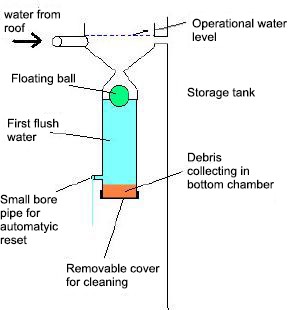Using rainwater
Rainwater offers a relatively clean source of water for numerous uses. Normally rainwater can be considered clean but if the air is polluted with chemicals or particles (for example, in an industrial area), it can become contaminated. It can also pick up contaminants from roofs and gutters.
Where water is very scarce and there is no safe alternative source, rainwater harvesting provides households with the water they use for all their domestic purposes. If the water is used for drinking and cooking, it should be treated using one or more of the methods described in Study Session 10. Some families may use rainwater directly without treatment because they do not have treatment facilities – but this is not recommended, as the water could be unsafe.
What are some of the ways in which rainwater is harvested?
From Study Session 3 you know that rainwater can be collected by roof catchments, ground catchments and sand dams.
People in urban areas are less likely to have to use rainwater for their basic needs but it can still provide a useful source for numerous purposes in the home. Devi et al. (2012), in research undertaken in rural and urban areas (Guma, Gambe, Suntu, Jimma and Daraba) in Oromia Region, found that rainwater was harvested and used for house cleaning, utensil cleaning, vehicle cleaning, washing clothes, bathing, giving to animals and watering plants. A total of 2050 people were interviewed and about 30% of those from rural areas used rainwater for drinking. The rainwater was collected from tin roofs in urban areas and thatched roofs in rural areas, and led into a collection tank. Rainwater was also harvested from surface run-off on the ground and stored in small storage reservoirs.
The researchers found that rainwater harvested from tin roofs, if disinfected, would be within the WHO guidelines for drinking water, while the rainwater from thatched roofs was not suitable for drinking. They calculated that a house with a tin roof area of 100 m2 could collect 126,000 litres in the rainy season, which would be twice the water requirement for a family of five, for a year.
If 126,000 litres of rainwater is enough for twice the water requirements of a family of five for a year, what is the daily water usage of each person used in the calculation?
It would be \frac{126,000}{2 \times 5 \times 365}\ = 34.5 litres
In urban areas, where space is more limited, roof collection is probably the only feasible method of rainwater harvesting. The recommended practice for roof collection is to let the first 15 to 20 minutes of the rain drain away, and then collect the water.
Why is it advisable to avoid using the first few litres of rain, especially after a dry period?
The first few litres of rainwater from a roof may contain contaminants from the roofing material, or from substances (such as dust, leaves and bird droppings) that have accumulated on the roof or in the gutter.
The diversion can be done automatically using proprietary devices like the one in Figure 11.5.

Figure 11.5 The floating ball first flush system.
In the floating ball first flush system, when the rain starts to fall it accumulates together with any debris in a chamber with a conical top. As the chamber fills, a ball floats on the surface of the collected water and eventually becomes stuck in the conical chamber entrance, blocking the bottom chamber and therefore redirecting subsequent collected rainwater into the main clean rainwater storage tank. This storage tank should have a tight-fitting lid that prevents sunlight from entering and encouraging algal growth, and also prevents entry of mosquitoes.
A small-bore pipe is used to slowly drain the water from the lower chamber of the floating ball first flush system, to automatically reset the device. A tap can be used if water is at a premium, since water dribbles out continuously when it is raining.